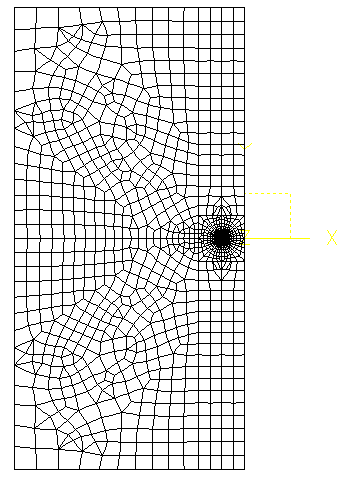3. Modeling A#
3.1. Characteristics of modeling#
It is a 2D modeling — plane constraints. The calculation of the evolution of stress intensity factors as a function of time is carried out in several stages:
calculation of the first 15 natural modes of the structure;
calculation of the intensity factors of the modal constraints associated with these modes by two methods;
resolution of the transitory dynamic problem by projection on a modal basis;
recombination of \(K\) modals.
3.2. Characteristics of the mesh#
The mesh is composed of quadratic elements. It has 2000 knots and 700 stitches and is refined around the bottom of the crack.

3.3. Tested sizes and results#
Modal values: non-regression test case
Mode number |
\({K}_{I}\) ( POST_K1_K2_K3 **) **) |
\({K}_{I}\) ( option K )) ** |
% difference |
1 |
-1,921.E+10 |
-1,898.E+10 |
1,2 |
2 |
-1,166.E+11 |
-1,152.E+11 |
1,3 |
3 |
8,039.E+10 |
7,948.E+10 |
1,1 |
4 |
-1,188.E+11 |
-1,174.E+11 |
1,2 |
5 |
1,723.E+11 |
1,705.E+11 |
1,1 |
Time values \({K}_{1}(t)\) : comparison to explicit resolution
Instant |
Reference |
Aster |
% difference |
0.0005 |
24055.6 |
24337.0 |
1.2 |
0.001 |
44676.8 |
45159.3 |
1.1 |
0.002 |
90592.3 |
91679.4 |
1.2 |
0.003 |
134065.3 |
135633.9 |
1.2 |
0.004 |
181113.3 |
183286.7 |
1.2 |
3.4. note#
The difference between the modal values calculated by interpolation of displacement jumps or by the theta method is small and consistent with that observed on static problems.
The value of \({K}_{1}(t)\) is calculated from the modal \({K}_{I}\) (K method) and the resolution coefficients on a modal basis directly in the test case by command lines in python:
\({K}_{I}(t)=\underset{i=1}{\overset{M}{\Sigma }}{\alpha }_{i}(t)\mathrm{.}{K}_{I}^{i}\)
where the coefficients \({\alpha }_{i}(t)\) are the modal participation coefficients, extracted from the result of the DYNA_VIBRA operator, and the \({K}_{I}^{i}\) are the intensity factors of the modal constraints.
The precision obtained is satisfactory considering the number of elements retained in the modal base. Precision increases rapidly with the number of modes [bib1].